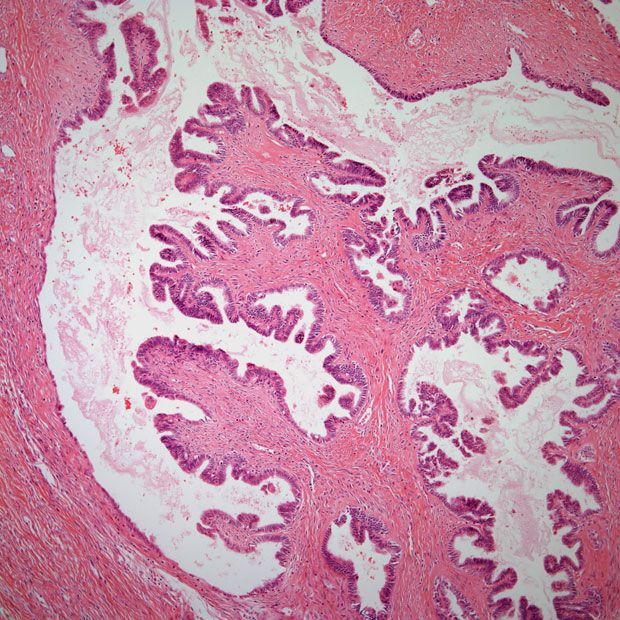Relacorilant May Be ‘Synergistic’ With Nab-Paclitaxel in Ovarian Cancer
Investigators of a phase 2 study suggest that relacorilant may add to a ‘sparse’ field of effective treatment options for patients with platinum-resistant or refractory ovarian cancer.
"These findings highlight the potential of glucocorticoid receptor modulation as a novel mechanism to restore chemosensitivity and enhance chemotherapy efficacy," according to the study authors.

The addition of intermittent relacorilant to nab-paclitaxel (Abraxane) improved survival and responses vs nab-paclitaxel monotherapy for the treatment of patients with platinum-resistant or refractory ovarian cancer, according to findings from a phase 2 study (NCT03776812) published in the Journal of Clinical Oncology.
At the primary analysis, intermittent relacorilant produced a median progression-free survival (PFS) of 5.6 months compared with 3.8 months in the monotherapy arm (HR, 0.66; 95% CI, 0.44-0.98; P = .038) after a median follow-up of 11.1 months. The intermittent therapy also yielded a median duration of response (DOR) of 5.55 months (95% CI, 3.75-5.88) vs 3.65 months (95% CI, 2.89-5.09) with nab-paclitaxel monotherapy (HR, 0.36; 95% CI, 0.16-0.77; P = .006). The median PFS attained with continuous relacorilant was 5.3 months (HR, 0.83; 95% CI, 0.56-1.22; P = .329).
With a median follow-up of 22.5 months at the time of the predefined overall survival (OS) analysis, the intermittent therapy arm yielded a median OS of 13.9 months (95% CI, 11.1-18.4) compared with 12.2 months (95% CI, 7.7-15.3) in the monotherapy arm (HR, 0.67; 95% CI, 0.43-1.03; P = .066). The corresponding figure in the continuous therapy arm was 11.3 months (95% CI, 7.5-16.4; HR, 0.85; 95% CI, 0.56-1.29; P = .447).
The intermittent relacorilant regimen also yielded greater OS in patients who had received 1 to 3 prior lines of anti-cancer therapy, including bevacizumab (Avastin), and did not have primary platinum-refractory disease. The median OS was 17.9 months (95% CI, 12.8-not reached [NR]) vs 12.6 months (95% CI, 6.4-15.3) with nab-paclitaxel monotherapy (HR, 0.38; 95% CI, 0.17-0.82).
“Effective treatment options for this patient population are sparse, and outcomes remain poor. This is especially true for [patients] with primary platinum-refractory disease, who are generally excluded from trials but were randomly overrepresented in the intermittent arm of this trial,” the investigators wrote. “These findings highlight the potential of glucocorticoid receptor modulation as a novel mechanism to restore chemosensitivity and enhance chemotherapy efficacy.”
This 3-arm, open-label study included patients with recurrent, platinum-resistant or refractory, high-grade serous or endometrioid epithelial ovarian, primary peritoneal, or fallopian tube cancer, or ovarian carcinosarcoma treated with 4 or fewer prior chemotherapeutic regimens. The total population included 178 patients from North America and Europe enrolled between April 2019 and July 2020.
All but a single patient had received a prior taxane. Of the total population, 36.5% had platinum-refractory disease, and these patients were overrepresented in the intermittent therapy arm. Most patients had high-grade serous disease (93.3%). The median patient age was 61 years (range, 38-81).
All patients received nab-paclitaxel by infusion once daily on days 1, 8, and 15 of each 28-day cycle. Randomization was performed in a 1:1:1 fashion.
The intermittent therapy regimen consisted of nab-paclitaxel at a dose of 80 mg/m2 plus 150 mg of oral relacorilant on the day before, the day of, and the day after administration of nab-paclitaxel. The continuous therapy consisted of the same nab-paclitaxel dosage plus oral relacorilant at 100 mg once daily. The control regimen consisted of nab-paclitaxel alone at a dose of 100 mg/m2.
The study’s primary end point was PFS as assessed by investigators. OS, DOR, and safety were among the secondary end points.
Serious adverse effects (AEs) occurred in 26.7%, 54.4%, and 31.7% of patients in the intermittent, continuous, and monotherapy arms, respectively. These consisted of gastrointestinal tract toxicities, or infections or infestations. Grade 3 or higher fatigue was more prevalent in the experimental arms vs the control arm. Conversely, grade 3 or higher neutropenia and peripheral neuropathy were less prevalent in the intermittent arm vs the control arm. All patients in the relacorilant arms, and 46.7% of those in the monotherapy arm additionally received granulocyte colony–stimulating factor.
The 2 limitations, as noted by the investigators, were the study’s open-label design and that baseline tumor glucocorticoid receptor immunohistochemistry was derived from archival biopsies, most of which were obtained more than 1 year prior to the start of the study.
“An agent with a convenient dosing schedule that can be synergistically combined with existing therapies, without cumulative toxicity or cross-resistance, is particularly desirable,” the investigators concluded. “The findings of the reported study suggest that relacorilant may be such an agent.”
Investigators of an ongoing phase 3 study (NCT05257408) will further explore the findings of this phase 2 trial.
Reference
Colombo N, Van Gorp T, Matulonis UA, et al. Relacorilant + nab-paclitaxel in patients with recurrent, platinum-resistant ovarian cancer: a three-arm, randomized, controlled, open-label phase II study. J Clin Oncol. Published online June 26, 2023. doi:10.1200/JCO.22.02624
Newsletter
Stay up to date on recent advances in the multidisciplinary approach to cancer.